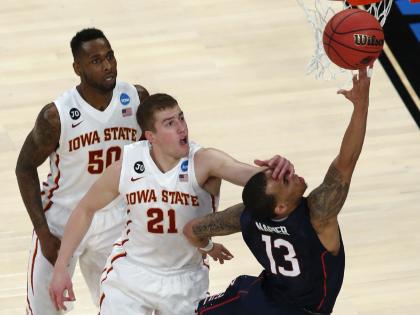How a Steve Nash drill has helped UConn advance deep into NCAA tournament

NEW YORK – Time and time again, Iowa State tried to mount one of those classic March comebacks, this time against Connecticut. And time and time again, the Cyclones grabbed momentum with a huge 3-pointer or big put back down low.
The UConn lead would drop to seven, or five. The Iowa State crowd would surge and the players' confidence would soar. Then the Huskies would dribble down the court, get fouled and head to the line. It was usually Ryan Boatright or Shabazz Napier or DeAndre Daniels, but it hardly mattered. Every time one of them, any of them, stepped to the line, they seemed oblivious to exhaustion or emotion. They just simply drained a couple freebies and stemmed the tide.
UConn won 81-76 here at Madison Square Garden to advance to the Elite Eight and truth is the single most important aspect of the game was also the most boring – free-throw shooting, especially down the stretch.
"The key to the game," UConn coach Kevin Ollie said. "We went 20 of 22 and every time they were scoring down their end, we converted to stop their momentum."
Sometimes it's that simple. Nineteen of those makes came in the second half. At one point they hit 15 consecutive. It's virtually impossible to come back on a team that gets two points every late-game possession.
College basketball, especially in the tourney, is often about who blows a game as much as who wins it and UConn simply wasn't going to let Iowa State have a chance. This wasn't some fluke either. In the NCAA tournament, the Huskies are now a ridiculous 48 of 53 (90.1 percent) from the line in the fatal final five minutes and overtime, literally slamming the door on comebacks.
"That's pretty good," Ollie said. "That's winning time."
It isn't by accident either.
In 2011, UConn assistant coach Glenn Miller was searching the Internet one day for obscure basketball practice videos. Maybe, he thought, he'd find something out there he could steal and use one or two times. That's when a free-throw shooting drill favored by two-time NBA MVP Steve Nash, a career 90.4 percent shooter from the line, popped up.
"Nash put 60 seconds on the clock and just tried to make as many free throws as he could," Miller said of Nash treating free-throw shooting almost like it was a Pop-A-Shot game at a sports bar.
"I'd never seen that before."
[Photos: Catch the best action from Connecticut vs. Iowa State]
Miller immediately understood the brilliance behind the drill. Historically, basketball players are taught to try to calm themselves down before attempting a free throw, often by going through an elaborate pre-shot routine of bouncing and spinning balls, pulling on their jersey, even mimicking a follow thru.
This was the opposite. There's no time to think, no time to sense the moment, no time for anything. Just shoot. It's all muscle memory.
"It's constant motion, it cuts down on all the unnecessary motion and I think it helps guys get into a rhythm," Miller said.

He took it to Jim Calhoun, UConn's head coach at the time who immediately was sold. When Calhoun retired, and Ollie, a longtime NBA player and UConn assistant was promoted, the drill remained.
Now three-to-four times a practice Ollie stops the action and sets guys up at foul lines. In one minute they need to hit at least 17 shots or they have to sprint the length of the court twice as punishment. "They don't like that a lot," Ollie said. Players can usually attempt about 23 or 24, depending on their speed.
UConn hit 76.1 percent of its free throws during the season, which was good enough for ninth nationally. That is just part of it though, Ollie said. He believes the "Nash Drill" is why the Huskies are so clutch. They are shooting 85.7 percent during the tournament and have been just uncatchable with a lead.
"We do it just for that reason," Ollie said. "It allows us to not think. It's rapid fire. The guys respond to it well. They get tired of me running it, but that's OK. As long as they keep knocking them down, I'm going to keep doing it."
The other key to the drill, the UConn coaches and players agree, is that rather than spend a long, slow segment during practice to shoot free throws, where heart rates can slow and nerves calm, the Nash Drill is so quick it can be incorporated multiple times throughout.
[NCAA tournament: Full bracket | Check out Instant Reactions | Buy team gear]
Ollie prefers to pull it out after a particularly vigorous spurt of practice, kind of like the demands of getting fouled while breaking a fullcourt press in the last minutes of an NCAA tournament game.
That's when, for decades and decades now, even great free-throw shooters have clanked away victories. This is the best way, he believes, to simulate the lonely, exhausted moments when a free throw matters most. The sprinting even adds an element of pressure.
"We try to break it up into different segments during practice when we are tired, when our legs ache," Ollie said.
UConn has won three games in this tournament. They have, they hope, three more to go. It's a little early to say they've figured out the formula – courtesy of a YouTube video of Steve Nash – to beating March's forever curse.
Just know they are going to run the Nash Drill on Saturday, when they practice for the Elite Eight.
Three, four, maybe five times, just in case.
